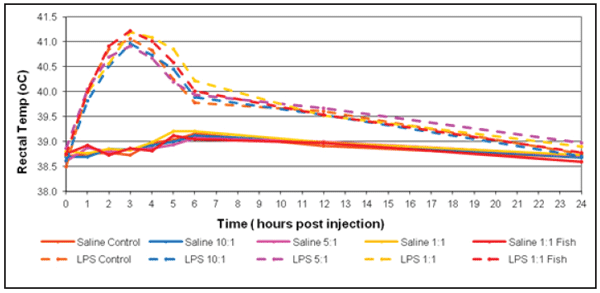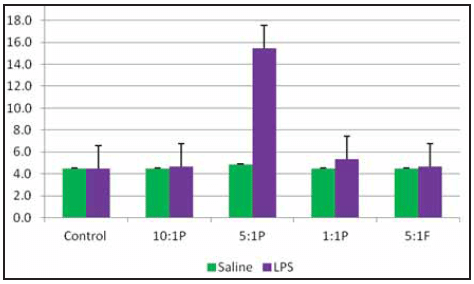Effects of Altering the Omega-6 to Omega-3 Fatty Acid Ratio in Starter Diets on Piglet Inflammatory Response
Published: March 26, 2014
By: Laura Eastwood, Ph.D. and Denise Beaulieu (Prairie Swine Centre)
Summary
An experiment was conducted to determine the effects of altering the omega-6 (n-6) to omega-3 (n-3) fatty acid (FA) ratio in starter diets on the inflammatory responses of piglets post-weaning. Piglets were subjected to an inflammatory challenge by injecting lipopolysaccharide (LPS), a component of gram-negative bacteria which triggers an immune response. Weanling pigs fed diets containing different n-6:n-3 FA ratios responded differently to an LPS induced immune challenge, and thus the FA profile of a ration may affect the response of piglets to inflammatory challenges in the nursery.
INTRODUCTION
Weaning is a critical time in a piglet’s life. They are exposed to many new stressors, including immune challenges. These stressors can lead to reduced feed intake and growth, and an inflammatory response will be generated. Although a certain degree of inflammatory response is beneficial during this time, an over-production of immune cells can be detrimental, leading to increased muscle degradation and reduced protein synthesis.
The n-3 FA’s are anti-inflammatory, and are known to have many different health benefi ts in a variety of species. Also, n-3 FA’s can alter the body’s release of cytokines, (proteins secreted by immune cells in response to stimuli) which assist in regulating the inflammatory response. Some of the most important pro-inflammatory cytokines are tumour necrosis factor (TNF-α), interleukin (IL)-1, IL-6 and IL-8.
This project was designed to determine if feeding a diet high in n-3 FA’s post-weaning could alter the inflammatory responses of piglets by reducing production of pro-inflammatory cytokines and improving piglet performance during an E. Coli LPS challenge.
Figure 1. Average rectal temperatures of pigs treated with lipopolysaccharide (LPS) or saline after consuming varying n-6 to n-3 fatty acid ratios for one week in the nursery. No eff ect of diet was found for body temperature at time zero prior to challenge; P > 0.05. No diet x challenge interaction was observed; P > 0.05.

MATERIALS AND METHODS
Weanling pigs (n=120) were randomized to one of fi ve dietary treatments immediately post-weaning (d 26 ± 2 days of age). Diets were formulated to contain varied n-6:n-3 FA ratios and consisted of a control (tallow based), plant based ratios of 10:1, 5:1, 1:1, and a fi sh based 5:1 ratio. Piglets were housed in groups of 2, and were given 6 days to acclimate to their surroundings and new diet prior to undergoing an inflammatory challenge. Piglets were then randomized to a challenge control group (saline injected) or to an LPS injected group (n=10/challenge/diet) and moved into individual pens for the 24 hour challenge period. Rectal temperatures were recorded at 0, 1, 2, 3, 4, 5, 6, 12 and 24 hrs post injection and blood samples were collected at 0, 2, 6 and 12 hrs post injection for cytokine analysis (IL-1β, IL-6, Il-8, TNF-α).
Figure 2. Diet by challenge interaction of plasma interleukin (IL)-6 concentration (mean SEM) for piglets injected with saline or lipopolysaccharide (LPS) when consuming varied n-6 to n-3 ratios post-weaning. P Values: Diet <0.01, Challenge 0.03, and D x C 0.01

Figure 3. Diet by challenge interaction of plasma interleukin (IL)-6 concentration (mean +/- SEM) for piglets injected with saline or lipopolysaccharide (LPS) when consuming varied n-6 to n-3 ratios post-weaning. P Values: Diet 0.08, Challenge <0.01, and D x C 0.13
RESULTS AND DISCUSSION
Piglets that were challenged with LPS consumed less feed and had reduced growth rates relative to those piglets who received a saline injection during the challenge period (P < 0.01).
Rectal temperatures were unaffected by dietary treatment (P > 0.05), but maximum body temperature was 1.8 oC higher in pigs injected with LPS relative to the saline controls, regardless of dietary treatment group (P < 0.01). Figure 1 shows the effects of starter diet and challenge on rectal temperatures for piglets throughout the 24 hour challenge period.
The area under the curve (representing cumulative output for the period) for plasma IL-6 was greater in pigs consuming the 5:1 plant based diets relative to those consuming the other diets (P < 0.01), as was the area under the curve for those injected with LPS. A diet x challenge interaction was present for plasma IL-6, with piglets consuming the 5:1 plant based diet having an increased response when injected with LPS (P = 0.01; Figure 2). Similarly, there was a tendency for pigs consuming the plant based 5:1 diet to have increased plasma IL-8 during the inflammatory challenge period (P = 0.08). There was also a tendency for a diet x challenge interaction, with pigs consuming the 5:1 plant based diet having a greater response when injected with LPS relative to the other diets, as shown in Figure 3.
CONCLUSIONS
Altering the n-6 to n-3 fatty acid ratio in the diets of newly weaned pigs can aff ect how they respond to immune challenges. Pigs consuming the intermediate n-6 to n-3 ratio of 5:1 had increased production of pro-inflammatory cytokines when challenged with LPS. Further work is required to determine the overall impact of these changes and how we can utilize them to help alleviate the post-weaning growth lag observed in the nursery.
ACKNOWLEDGEMENTS
Strategic program funding was provided by Sask Pork, Alberta Pork, Manitoba Pork Council and Saskatchewan Agriculture and Food Development Fund. Specifi c funding for this project was provided by Alberta Livestock and Meat Agency (ALMA) and Vandeputte s. a., Belgium.
Related topics:
Authors:
Prairie Swine Centre Inc.
University Saskatchewan
Recommend
Comment
Share
Insta-Pro International
31 de marzo de 2014
Thanks. Why do you think the plant 10:1 ratio did not maximize the inflammatory response?
BTW, I knew Denise many years ago.
Great work....
Recommend
Reply
Insta-Pro International
31 de marzo de 2014
Are the diet formulations published somewhere? Interesting results...
Recommend
Reply
Prairie Swine Centre Inc.
31 de marzo de 2014
It is possible that pigs did not consume diets long enough prior to the challenge to see the expected result of maximized response with the 10:1 diet. However, it is also possible that the increased response observed by the 5:1 pigs when challenged is beneficial, in that they have a greater ability to mount a response when needed but have a possible lower 'background level' when not challenged. Further work needs to be done to determine what is 'beneficial' and what is 'detrimental' to the pigs at this time.
P.S. Denise says Hi!
Recommend
Reply
Prairie Swine Centre Inc.
31 de marzo de 2014
The diet formulations have not been published as of yet. They were wheat and barley based (ranging from 24-42% wheat and 10-20% barley) with 21-24% soybean meal. We adjusted the fatty acid profile using corn, flax seed meal (13% fat), corn oil, flax oil, tallow (control diet) and fish oil (5:1 fish diet). Diets also contained 2.5% spray dried animal plasma and 15% dried whey as well as all the required vitamins and minerals to balance them according to NRC 1998.
Recommend
Reply

Would you like to discuss another topic? Create a new post to engage with experts in the community.









